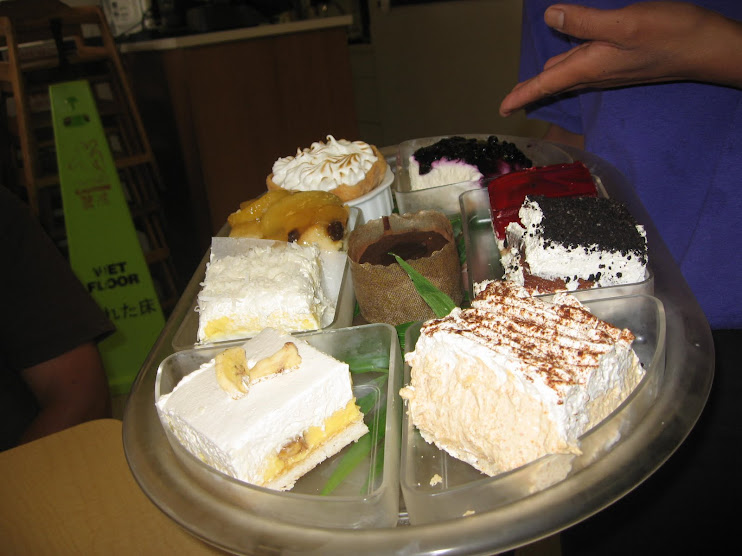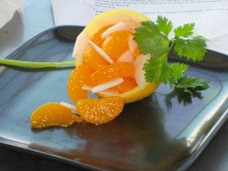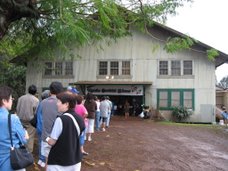The bread recipe I'm going to pass on is nothing short of wonderful. I don't impress easily. I've read thousands of recipes but this one seemed too good to be true. A simple bread recipe that you don't have to knead and, according to Jim Lahey, the professional baker who created it, rivals any commercially made bread in the country?
My LA pastry chef/instructor friend, Tina, (Mahalo plennny, Sistah!) sent me a link, several days ago, to an article written on 8 November of 2006 in the NY Times by Mark Bittman titled "The Secret of Great Bread: Let Time Do the Work". The recipe and the accompanying video about Lahey's recipe sounded and looked intriguing. Water, flour, yeast and salt and no special equipment? Perfect, artisinal style French bread? Tell me more!
My first attempt made with regular white flour in a 3.5 qt., stainless steel Belgique stockpot flattened out too much and did not have sufficient structure. I let it rise the full 18 hours. The bread did show promise. Do you know how really great French bread tastes cool as if it had been in the fridge? I have no other way to describe it. This bread has that. It had a great crumb, shattering crust and an almost sourdough taste. I just needed to find a good substitute for the heavy enamel Le Creuset pots that Jim Lahey uses to create the steam needed. Steam is important to make the dough rise properly and to create that great crust in the oven.
On my second try, I changed the regular flour to bread flour and baked the dough in a heavy Pyrex mixing bowl which is narrower on the bottom than the top. This feature is necessary to create height in the bread. I placed the Pyrex bowl in a covered terra cotta roaster to create the steam oven effect. The roaster also protects the Pyrex which can shatter at temperatures over 350 degrees. I then placed this whole baking set up on a pizza stone for extra insulation. Since our room temperature is about 80 degrees now, in the summer, I experimented and cut the first rise to just 4 hours. The flavor was less like sourdough and more like regular French bread but still very good. The extra long rising, as in my first attempt, ferments the dough. At left you see the results of my second attempt. Without a doubt it is the best French Boule I've ever made.
It is critical that you use the correct baking vessel or a combination of baking pieces to create a mini steam oven. Jim Lahey suggests using a cast iron, enamel, Pyrex or ceramic vessel for baking. It must have a cover and it must be thick and heavy. It should be narrower on the bottom if you want height to your bread. I improvised with what I have on hand and instead of one baking vessel I used two. I used a 2 qt. Pyrex mixing bowl set into a terra cotta roaster. The dough has to be extremely wet as well. Shirley Corriher (food chemist/author/frequent authority on Food Network's Good Eats) uses a similar wet technique in order to create fluffy, high biscuits.
To find the original article (NY Times, 8 November 2006) and video do a search on these words-
"The Secret of Great Bread Mark Bittman"
and a link to the original article will pop up. There are over 1200 links, emails, chats, even clubs that have sprung up. Hundreds of bakers are obviously excited over this new technique. I would highly recommend that you read the article prior to making the bread. Then, read through the recipe below before proceeding. It seems complicated but after making it once it will be very simple to make again.
NO KNEAD BREAD-French Boule
Adapted from Jim Lahey’s (owner of Sullivan St. Bakery in NY) recipe and
Matt Bittman's NY Times article published on 8 November 2006, “The Secret of Great Bread: Let Time Do the Work.”
3 c. King Arthur unbleached bread flour
¼ t. yeast, dry
1 and ¼ t. salt
additional flour, cornmeal, wheat bran or sesame seeds for covering and dusting
1 and 5/8 c. of water
In a large bowl combine flour, yeast and salt. Stir until all the ingredients are distributed evenly. Start with 1 and ½ c. water. As you mix, add 2 more “splashes” of water but not more than a total of 1 and 5/8 c. The dough should be shaggy, sticky, very wet and almost unmanageable. Mix until combined. Do not knead. Place in a greased plastic bowl and cover dough directly with plastic wrap. You can place the bowl in hot water to start the rising.
Let dough rest from between 4-18 hours depending on convenience and room temperature. The flavor develops over time. It should double and be covered with bubbles.
Scrape dough with a bench scraper onto a Silpat covered with flour. (See Note below to use flour-covered towels instead of a Silpat) Fold it over on itself once or twice. Let rest 15 min. Place dough into a greased plastic bowl set over hot water. Sprinkle with flour. Cover loosely with plastic wrap and let it rest for between 1-2 hours. Dough should be double in size and should not readily spring back when poked with a finger.
1/2 hour before baking, preheat oven to 450 degrees. Place a greased 2 qt. Pyrex mixing bowl set in a terra cotta roaster with a cover (or directly into a 3.5-8 qt. ungreased enamelled cast iron or greased cast iron, enamel, Pyrex or ceramic vessel with a cover) in the oven to heat for the half an hour. If you have a pizza stone it would be good to set this in the preheated oven as well. When dough is ready to bake, drop the dough into the hot Pyrex dish which is set in the terra cotta roaster. Shake to distribute evenly. Cover. Set on the pizza stone, if you have one. Bake covered for 20 min. and uncovered for 30 min. at 450 deg. Cool on a rack. After bread is completely cool you can store it at room temperature in a paper bag.
Note:You can also use towels, not terry cloth, lightly covered with flour instead of the Silpat and the bowl for the second rising.
In a follow up article, (NY Times, 6 December 2006 "No Kneading, but Some Fine Tuning") Mark Bittman noted that you can fold other additional ingredients into the bread at either the beginning of the recipe or after the first rising. Some suggestions are: roasted garlic cloves, sundried tomatoes, olives and herbs. Rosemary is perfect. Bittman also said that readers have given him feedback that you can use fish roasters for baguettes, muffin tins for rolls and regular loaf pans for the more traditional loaves but I haven't had a chance to experiment with these.
I will be making this bread often. The fragrance of the baking bread is indescribable. The taste, crumb and texture is superior to any bread I've made. My hope is that by publishing this recipe it will encourage you to try it. Then, share the bread and the recipe with those you love!
-foodiewahine
ps: Third batch-I sprinkled the top with a mix of poppy-seeds and sesame seeds, 1 T. each, prior to baking. Messy to eat, but adds a nice crunch and nutty flavor. Tina just pointed out to me that 50,000 people have viewed the video accompanying Bittman's article!
pss: Fourth batch-macerated dried bing cherries in rum and added pecans then topped bread with wheat bran. An 'ono breakfast bread.
If anyone tries this recipe please leave a comment how it turns out! I'd love to hear!
Subscribe to:
Post Comments (Atom)






































2 comments:
will your posts be changing in relation to your new found information from Dr. Shintani?(raising eyebrow). i went and bought lots of fruits and veggies yesterday, and brown rice, and whole wheat pasta today. (is whole wheat pasta ok?)
Yes, whole wheat pasta, buckwheat soba, all those pastas made with whole grains are excellent. It's fortuitous that you asked, Samantha, because I'm online to do a blog on the Shintani workshop.
Thanks for the encouragement!
I've found that one secret to brown rice is to soak it for at least 2 hours but 4 is even better. Then you can cook it in the rice cooker using just a bit more water than you would for white rice.
-foodiewahine
Post a Comment